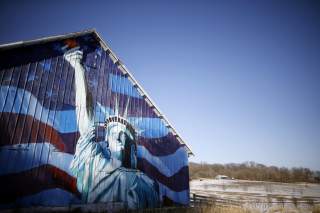The Great Partisan Divide Is Good for America
American democracy is healthier than ever, and partisanship is the reason.
Every four years the country’s political elite gets all worked up over politics—and hardly anyone else notices. In the midterm election years, that is. The midterms often feel more like a charity walk-a-thon than a Usain Bolt sprint; sometimes it seems like no one is really “running” at all. The candidates’ names may change, but their policies remain the same. Sometimes even the names don’t change for decades on end.
This year is different. If you love Brett Kavanaugh, big coal, American manufacturing, tax cuts, and the stock market, vote Republican this November 6. If you hate Brett Kavanaugh, but love the Paris climate accord, peace with Iran, and big government—and want to see Donald Trump impeached—vote Democrat. Midterm voting hasn’t been this easy in decades.
A healthy democracy requires clear choices like these. Political pundits spend hours each day parsing candidates’ voting records, but ordinary voters don’t. Political pundits love to see the two major parties cooperating to pass major legislation, then going out to the same Washington bars to celebrate together. But for ordinary voters, that makes all politicians look pretty much the same. And if they’re all the same, why bother voting at all?
And for several decades, they all did pretty much look the same. There was an elite consensus in Washington that took issue after issue off the table and out of politics. Call it bipartisanship if you want, or call it conspiracy. Either way, for years the American people had little choice over key issues like free trade, bank bailouts, and the federalization of K-12 education. Democrats and Republicans came and went, but the elite agenda just kept moving forward. The return of partisanship threatens all that—and it’s about time, too.
Reasons to Vote
As American politics have slowly become more partisan, American voters have started to return to the polls. Voter turnout in was consistently high in the 1950s and 1960s as the country grappled with desegregation, civil rights, the Great Society, and the war in Vietnam. Back then, Presidential elections really did have consequences. No 1950s Democrat would have sent the 101st Airborne to integrate Arkansas schools, and no 1960s Republican would have given us Medicare.
Presidential elections mattered much less in the seventies, eighties and nineties. Pierce through the hazy feel-good (or feel-bad) memories of times gone by, and you’ll find that Richard Nixon gave us the Environmental Protection Agency, Jimmy Carter ordered the Army into Iran (it’s not his fault that their helicopters crashed), and Ronald Reagan of all people presided over one of the biggest expansions in the federal government in history. George H.W. Bush and Bill Clinton together gave us NAFTA and the WTO.
Amidst all this bipartisanship, voting in Presidential elections bottomed out. The only spark in Presidential voter turnout between 1972 and 2004 was the 1992 election contested by the independent Ross Perot. Since the return of partisanship in the 2000s, voter turnout in Presidential elections has climbed back to its postwar average of around 55 percent. That's because as elections have become more partisan, they have become more important. The Trump factor all but assures that voter turnout will soar to a new high in 2020.
Turnout in midterm Congressional elections, by contrast, never bounced back. In fact, it hit a new postwar low in 2014. The reason is simple: gerrymandering. Instead of fighting things out at the polls, the Democrats and (especially) the Republicans prefer to crack and pack the electorate into highly artificial “districts” that provide them with safe, noncompetitive seats. These days, when it comes to congressional elections, the voters don’t choose their representatives. The representatives choose their voters.
Bring on the Breitbart
Perhaps the biggest single factor behind the rise of partisanship in the 2000s was the birth of Fox News. Launched just before the 1996 elections, Fox News has been the dominant cable news channel in America since 2002. Its obvious partisan tilt has freed other news outlets, like MSNBC on cable to the New York Times in print, to become more openly partisan as well. The idea that the news should be “fair and balanced,” so dear to political scientists and media scholars, is now so old hat that it has even been abandoned by Fox News itself.
If you worry that television and newspapers have become too biased, don’t even look at the internet. Everyone knows how Breitbart’s Steve Bannon went to bat for Donald Trump. But on the other side of the partisan divide, fifty-seven out of fifty-nine major American newspapers endorsed Hillary Clinton, to say nothing of all the progressive websites that relentlessly promoted Bernie Sanders. It’s like a return to the 1890s, when the likes of Joseph Pulitzer and William Randolph Hearst were battling it out for readers with hyper-partisan yellow journalism
Incidentally, voter turnout in the election of 1896 was 79.3 percent, a figure never again reached in U.S. election history. The election pitted the fiery progressive Democrat William Jennings Bryan against the arch-conservative Republican William McKinley. Everyone knew where the candidates stood on the big issues of the day, and they got what they voted for: McKinley, protective tariffs, and the gold standard.
Academics are still debating whether or not those were the right choices. But that they were popular choices was proved in 1900, when McKinley beat Bryan again, this time by an even wider margin. Democracy requires choices, and back then the two major parties offered real choices to the American electorate. Today’s return of partisanship means the return of choices. Whoever the Democrats put forward in 2020, one thing is clear: Trump will give the voters a clear choice. And that’s just what democracy needs.
Salvatore Babones is the author of The New Authoritarianism: Trump, Populism, and the Tyranny of Experts.

